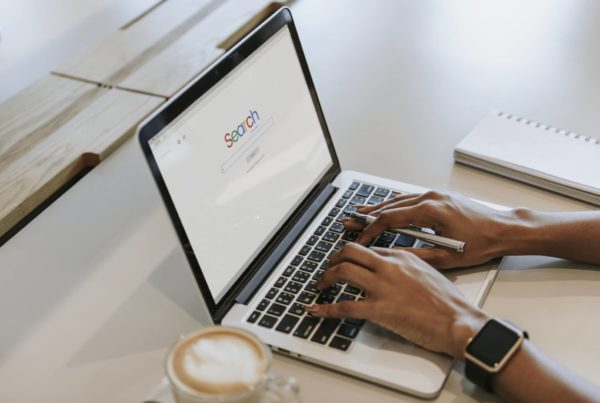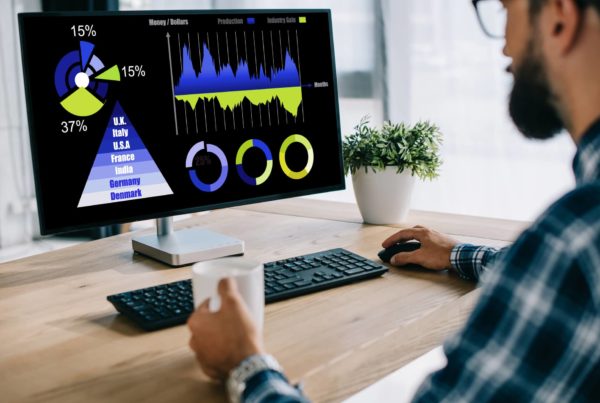Have you started with your website’s Internal Links Strategy? Are you finding it completely unnecessary to devote your time & effort doing Internal Linking within your web pages? Are you planning to switch to other ways of generating web traffic? Then we suggest you stay calm and review the article as follows.
Whenever you create a website you come across various internet standards and norms set by the search engines. Besides learning, most of the websites are created to represent a form of business with a variety of products and services to offer. Google is also famous for its algorithm updates that are consistently introduced within a span of 2-3 years. This is simply done to enhance the usefulness of the search engines. Internal Linking is just another technique through which you can optimize your website’s search engine presence.
When you get started with your website, you’re often suggested to put it on Google Analytics so that your domain becomes visible to the search engine crawlers right away. We often call them Google Bots as Google is the most-visited and popular search engine across the world. The sooner your website gets recognized by the Google Bots, the quicker it gets indexed on the search engine. Indexing of your domain is really important if you want to rank high on the SERPs. Your website’s Internal Linking is also associated with the search engine crawlers and affect their actions essentially.
If you think that external backlink is alone capable enough to bring you the best search engine results, think again. Through this article, we’re going to represent to you the essence & importance of Internal Linking with respect to your website, in the form of answers to the following queries you might have:
- What are Internal Links?
- How Internal Links Improve Your Search Ranking?
- Factors to Consider for Internal Linking
- Leading SEO Tips to Improve Your Internal Links Strategy
By going through the article you may also develop a set of knowledge to direct a specified group of webmasters who are new to the world of website creation & maintenance. Let’s have an overview.
What Are Internal Links?
Internal Links are situated within your own website pages. When you link back from one webpage to another webpage in the same domain, it is called Internal Linking. Internal Link does not target other webpages alone, it may also redirect your visitors to the download page, media files, registration forms, call to action page, and more. It means Internal Linking also associates with other resources on your website.
Internal Links are generally focused on a specified webpage on your website that you want maximum visitors to explore. It is really helpful in case you want your visitors to reach a buying decision. Unlike external links, you don’t have to approach multiple referring domains to improve your search engine optimization goals. Though Internal Linking is quite easier as you just need to inspect your own website, you also need to make sure that you’ve got enough blog posts & webpages to link back.
If you want to rank a specific webpage on your website you need an adequate number of Internal Links pointing toward it. Take care of the right keywords too. This way, you could let Google Bots acknowledge your targeted webpages quickly. Some famous forms of Internal Links could be:
- Links to Home Page
- Links to Landing Page
- Links to Products & Services
- Links to Drop-Down Menu
- Links to Contact Information
- Links to About & Introduction Pages
- Links to Shopping Window
- Links to Post Feed and more
Sharing the idea of your website structure with Google surely helps you grow faster across the SERPs, and therefore, Internal Linking is the procedure you can’t refuse to undergo in this context.
How Internal Links Improve Your Search Ranking?
Besides referring domain, your website’s search engine rank also depends on other notable factors. Internal Linking is one of them. Internal Linking helps your visitors and search engine crawlers to understand the complete organization of your website. They find it easy to jump to another webpage of their interest if they plan to explore further. Creating values & relationships among different webpages of your domain is very essential for the web crawlers to examine your website’s characteristics.
Google has recently started considering at least 1000 Internal links to be sound for a single webpage. The more the links targeted to a web page, the more it will shine before the Google searches. Your web pages get indexed faster than usual resulting in enhanced click-through rates and conversion rates on part of the consumer traffic your website acquires.
However, there are additional ways through which Internal Links capture your search engine ranking and works to improve it exceptionally. Let’s find out how.
1. Creating Content Networks
Content networks are usually created by the webmasters who usually run a blogging website. Internal Linking is a perfect way to create a content network around a pillar page you want to target. There are some key subjects & topics you may consider to contribute to the pillar page that, in return, provides for the Page Authority of all other web pages. This way you could rank all of them on the SERPs collectively.
2. Minimizing Page Depth
If you have a target web page to rank in the search engine results you have to make it easy or direct to reach. We’re not talking about the external linking here. A lot of visitors often don’t like to review your website’s landing page or home page frequently to find their favorite blog section. As such, Internal Links play an important role to keep them reading out more. It generally reduces the bounce rate.
3. Enhance the Reader’s Interest
Reading is indeed a fantastic thing. In this era of digital networking, people don’t like to approach multiple books to conduct one subject-specific research. They’ve got separate websites for separate solutions. If you’re running a single niche website, Internal Linking could engage a specific group of audiences all day to your blogs.
This way you may consider Internal Links to be an indivisible part of your search engine ranking strategies. You could also approach on-page SEO experts to help you out with this.
Factors to Consider Before Internal Linking
Although Internal Links form a very basic portion of your SEO strategy, they are very important to get established across all the web pages. A lot of factors are involved in your website’s Internal Link Structure. These factors decide whether you could proceed with your Internal Linking strategy in the future or not. They also help you to figure out whether you need to pay more or less attention to your external linking strategy.
These factors usually represent the characteristics & features of your website and let you understand the impact of Internal Linking on your website’s presence on the search engines. Without taking them into account you can’t build a strong Internal Linking strategy for your website. Let’s review them one by one:
1. One Website
For Internal Linking you must have a website of your own. If you’re not a self-employed man you may consider your client’s website as a personal one. Internal Links have nothing to do with the external domains or say referring domains. You have to create a relationship between various web pages & resources of a common website. Therefore you can’t think of 2 websites anywhere in the story.
2. Traffic & Visitors
When your website is new to the search engines it usually needs an initial form of traffic to become reputable before Google. When you say initially, Internal Linking has to contribute a lot to bring traffic to the website. On the other hand, low or high traffic could help you decide on your internal linking modification if any. So you see, both of the concepts are inter-related. Additionally, Internal Linking throughout a specified group of articles & topics could enhance the traffic right away. Also, the visitors who like to read different types of stuff could make you change your Internal Linking Strategy.
3. Search Engine Norms
The search engine rules & protocols are consistently changing since the inception of the Panda update in 2011. There were many emerging sources of Internet manipulation before that. The quality of web content became a matter of concern. And then, Search Engine Algorithms steps in. Today, you could find many innovative ways suggested by the Google Algorithms to make your Internal Linking more effective. You just have to undergo a detailed study.
Leading Tips to Improve Your Internal Links Strategy
Internal Linking is a leading or primary step toward your website’s introduction to online traffic. With the passage of time, you learn how to bring more traffic to your web pages, products & services. For this reason, your Internal Link Strategy needs to upgrade from time to time. It means you have to maximize your Internal Links accordingly. Sometimes, the number of Internal Links on your web page isn’t enough to bring substantial results. Lots of new webmasters face this problem and build a misconception that Internal Linking isn’t worth it.
As such, SEO experts keep suggesting different techniques to optimize the website’s Internal Links. In this article, we have mentioned various aspects of those techniques to help you easily understand how you could improve your Internal Linking efforts. Here are some tips to provide you a precise form of assistance on this.
1. Get Rid of Duplicate Links
Duplicate links usually acquire unnecessary space in your google index due to which your SERP appearance takes longer than usual to shine. As a result, it also affects your internal link optimization plan without being visible to you. Though having multiple links pointing to a single webpage is the main USP of the Internal Linking technique, your webpage often invites inadequate duplicate links that Google Bots never counts.
Furthermore, multiple unnecessary links to the same page could affect your PageRank. Talking about e-commerce, a fine portion of Internal Linking essentially relates to consumer decisions. If there is a lot of unwanted Internal Linking, it may also lead to an unwanted number of conversion rates you won’t be able to accomplish. Therefore, you must take care of the drawbacks of Internal Linking.
2. Application of Anchor Text
How about making your internal links appealing enough to acquire potential traffic within a small portion of the time? Keywords are the backbone of on-page as well as off-page SEO. And, you simply need to grab the benefits of it. Anchor text is the keyword you mention in the blog article. It is present in the form of a hyperlink (backlink) that targets your specified web page. It can be used to carry both Internal and External links.
The aim of anchor text is to charm prospective visitors to jump to the targeted web pages if they wish to explore additional aspects of the products, services, or information they’ve come across. Therefore, you must conduct keyword research to exactly offer them what they want. The technique works for both internal and external linking.
3. Work on Engagement
The term simply depicts the quality of content you need to accomplish. It doesn’t matter what type of content you want to exhibit before the internet surfers. They must get engaged in it and wish to know more. Information is the core of social, personal, and professional interactions on the internet and you need to offer them the best information available about anything they love. This principle works for both internal & external linking you’re planning to conduct.
If you’re quite good & easily available for content writing, you could build the potential to engage your target audience to fetch your Internal Linking goals. Or else, you can approach a reliable team of content writers & graphic designers to exhibit your thoughts in multiple ways. Considering the writing part, you must take care of your vocabulary as your visitors may come from different parts of the world. Also, take care of the spelling, grammar, and plagiarism as people may ignore your minor errors, but the search engines won’t.
4. Make Use of Contexts
Before making use of a context, let’s understand what it is. In a basic language, context is something that intensifies your message’s appearance. Coming back to websites, your anchor text or hyperlinks usually represent a message or a piece of information that needs your visitors and target audience to click & reach your web page right away. Adding an appealing background or some kind of graphic stuff to such anchor texts or internal links would surely help you grab your target audience.
The context could be an image you need to upload around your internal link so that the visitor immediately gets your message. Though it is not necessary that the visitor surely clicks on the link, it has shown incredible results for numerous Internal Linking cases so far. Just go for it!
5. Bring Some Uniqueness
The next point also relates to the usage of anchor text. A target web page usually requires so many numbers of internal links, but that doesn’t mean you can go with identical anchor texts from different pages. You must also include variations in anchor texts related to a single article. It means if you link back multiple times from a single article to a common web page, try to use different anchor texts. This technique links multiple keywords to your web page allowing different visitors to reach you from the same article.
6. Avoid Low-Value Links
PageRank Sculpting is a renowned technique that includes various sub-methods to improve your page rank & page authority before the search engines. It also considers your Internal Linking efforts to be a major factor in this context. As such, they suggest you remove all the low-value links coming to your target web page. Why is it so?
Certain internal links provide no benefits to your SEO goals as they are no longer visited by any individual. The reasons could follow different circumstances. For example, an outdated product or service, an old form of information, or an irrelevant anchor text in the article. Such links often become low on their value and eat out significant space.
7. Make Sure on Relevance
The next point suggests you remain relevant to your internal linking procedure. If you aim to unnecessarily link back to a web page that has nothing to do with the anchor text, context & hypertext on the other pages, you’ll surely achieve an awful bounce rate you won’t like the search engines to review. You must focus on sharing the right information with the audience before targeting their buying decision.
Final Thought
Both Internal Links & External Links provides for your on-page & off-page SEO goals. However, conducting effective SEO strategies require adequate knowledge & understanding on your part. Google always helps different emerging & honest webmasters to exhibit their business ideas before the prospective online surfers & shopping freaks.
Through the medium of this article, we want you to learn a unique aspect of the search engine ranking system so that you don’t get mislead by the negative side the internet marketing in the long run. You’ve got a long way to go!




